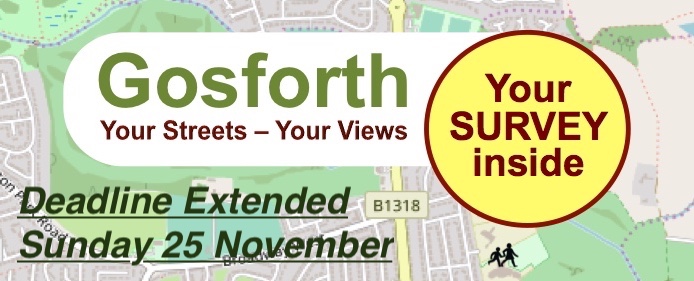
Your Streets – Your Views
We want to know what you think about your streets.
If you live in the former East or West Gosforth council wards or in Parklands ward, you should have had a survey leaflet through your door.
You can do the survey online, or fill in the leaflet and post it back to us, until Sunday 25 November.
Please tell your friends, family and neighbours about the survey and ask them to do it too. The more people who take part, the better the picture we will have of Gosforth as a whole. We are interested in everyone’s views – no matter how young or old you are, or how you travel.
If you or you know of anyone who may have visual impairments and would like help to understand the information and/or help completing the survey please do let us know. Even if we are unable to help with the current leaflet it will assist us for future publications.
Click here for a pdf version of the survey leaflet.
Here’s some more info on some of the issues we’ve thought about:
| Buses | Safe Streets For All |
| Pavement Parking | Healthy Streets? |
| Road Danger | Speeding |
| School Run | Air Pollution |
Any questions? Just ask in the comments below.
Please complete the survey online here: 
Lastly, if you’re not already a member of SPACE for Gosforth, you can join here – it’s free!
Thank you!
The printing and distribution of the survey leaflet has been made possible by grants from East and West Gosforth and Parklands council wards. Further details on funding are provided at the end of this blog.
| Buses There are more than 25 services every hour on the Great North Road, one of the best-served bus routes in the North East. |
We’ve worked out from bus timetables that there are more than 25 stopping services travelling down the Great North road every hour, so you will rarely have to wait more than a few minutes if you want to catch a bus to Gosforth High Street or the city centre.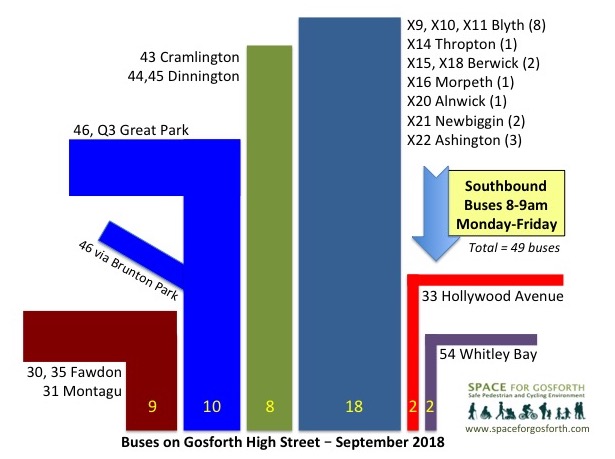
It is also possible to catch express buses from Brunton Lane, Regent Centre or the High Street by The Brandling Arms into the city or out into Northumberland. These buses are also used by people living outside the city to shop and use the services on Gosforth High Street.
| Pavement Parking 97% of blind or partially-sighted people in the UK encounter problems with street obstructions. 90% of those had experienced trouble with a pavement parked car. We tried a blindfold walk on Gosforth High Street. |
Guide Dogs, who commissioned the research we have quoted from, want pavement parking to be the exception, not the norm. This is their campaign video.
RNIB also campaigns on Pavement Parking. They say “Clear pavements are essential for blind and partially sighted people.”
Pavement parking can also damage paving slabs, creating trip hazards and requiring costly repairs.

| Road Danger Gosforth has some of the most dangerous roads and junctions in the city. |
Arguably it is worse than that. The Chronicle has reported that Newcastle is home to four of Britain’s most dangerous roundabouts. Two of these, the most dangerous roundabouts in Britain, were Blue House and Haddricks Mill junctions, both in Gosforth.
We are still waiting for the Council to act to improve safety at these roundabouts and at other locations in Gosforth. This is the video released by the council in 2016 explaining why these junctions need to change.
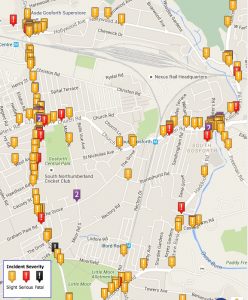
Maps are available on-line showing where people have been injured in road traffic collisions. This map and the one on the printed leaflet are from www.crashmap.co.uk.
This shows very clearly that Gosforth High Street also has a poor safety record.
How can we stop people, our friends and family, being injured or killed on the roads?
Street design is key – to prevent excessive speed and to keep people and vehicles separate.
Two very effective approaches are Sustainable Road Safety from the Netherlands and Vision Zero, which originated in Sweden but has now been adopted internationally. Both approaches start from the view point that people are only human, so roads should be designed to minimise injury rather than relying on road users to always follow rules and avoid mistakes.
| School Run Children are most likely to be injured going to or from school. How can we enable children to walk, scoot and cycle safely, and reduce school-run traffic? |
In 2009, Newcastle City Council commissioned a survey about how children travel to school as input to its Draft Sustainable Modes of Travel Strategy. This was one of the most striking results.
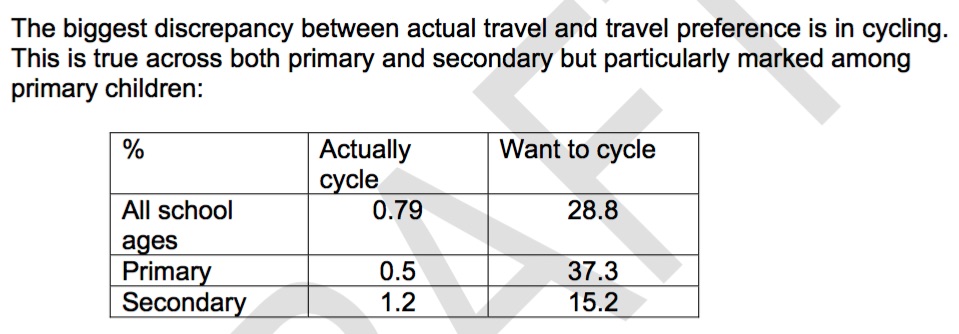
Road danger is a very real issue. In Gosforth children have reported prams nearly being knocked over and cars driving very close to children on bikes and scooters.
There is no reason children shouldn’t walk or cycle to school, if streets are designed to accommodate them and protect them from danger. This video is from the Bicycle Dutch blog showing how a Sustainable Road Safety approach does exactly this.
In the UK as a whole, children are losing the ability to travel independently, are now the least active in history, and we have record high levels of severe obesity in ten and eleven year olds. Having an environment where children can be independent and active would help to address all these problems.
| Safe Streets For All We speak to lots of people, young and old, who tell us they don’t feel safe cycling around Gosforth. That means more people using cars instead, leading to more congestion and more pollution. |
Everyone should be able to travel safely and feel safe while they do so, regardless of whether they happen to be walking, cycling, driving or using public transport.
Nationally many people say they don’t feel comfortable cycling in traffic and Gosforth is no exception. Despite that, in Newcastle, currently about 7,000 return cycle trips are made daily by people that could have used a car. If these cars were all in a traffic jam it would tail back 21 miles.
It is perhaps not surprising then that the Netherlands, with it’s well designed cycling facilities, has been ranked the best country in the world for driving, and that Dutch children are the happiest in the world,
This video is about cycling in Newcastle’s twin city Groningen, where 60% of all traffic movements are by bicycle. Imagine the tail backs if all those journeys were by car. It’s quite a long video (15 minutes) but it doesn’t take long to get the idea of what it’s like.
Newcastle would be an ideal place for cycling if only there were more facilities to make it safe to do so. It is one of the driest cities in the UK, as well as being relatively flat and compact.
We’ve written about how we could build a safe cycling network for Gosforth, and about routes in Gosforth that are suitable for children and those which are not. Grandstand Road is a good example of a road with cycle lanes that aren’t suitable for children, nor for most adults. We’ve also asked the Council to prioritise clearing snow and ice from busy pavements and cycle paths.
| Healthy Streets? Good street design enables active travel like walking and cycling for all ages and abilities, supports accessibility, and minimises danger, noise and pollution. |
Healthy streets improve people’s health, make places socially and economically vibrant and environmentally sustainable. The Healthy Street approach aims for streets that are safer, cleaner, quieter and where people feel welcome.
Part of this is designing streets so that walking and cycling are seen to be really good options for local journeys. Just walking or cycling to work can dramatically improve your health. According to Glasgow University, people who commute by cycle have 41% lower risk of premature death. That’s despite additional danger due to cycling in traffic. People who walk to work have a 27% lower risk of developing cardiovascular disease.
We have produced a summary Case for Healthy Streets, which includes links to evidence about how more active travel improves people’s health, the environment and the economy. Walking and cycling also saves money (cycling rather than driving is equivalent to a 8% pay rise). We have also asked if protected cycle lanes are good for business? The evidence says they are.
Healthy streets are also accessible for people with disabilities. You can read our blogs about our blind walk Gosforth High Street and reviewing the new Salters Road junction. The Equalities Act 2010 requires that Highways Authorities do not put people with disabilities at a substantial disadvantage compared with someone who is not disabled. We have written about how this applies to the Three Mile Inn footbridge. The same is true for the footbridge over the Metro from Hunter’s Road to Garden Village.
| Speeding On roads with this symbol up to 85% of drivers do not stick to speed limits. There are large numbers of vehicles cutting through these residential streets. |
We are fortunate in Gosforth that most residential streets have a 20mph limit. 20mph is set to minimise the likelihood of serious injury or death following a collision.
Even at 20mph there is a 5% chance of death following a collision between someone walking and a car. At 30mph that increases to 40%, and at 40mph there is an 80% chance of death. These are average figures so for older or younger people the risk of death will be higher again. This should be reason enough for everyone to drive within the speed limits.
Using Council data we have worked out how many vehicles are being driven faster than the speed limit for a number of roads in Gosforth. The graph below is for Ilford Road. You can see the other graphs on our Flickr Album and in our blog 1000 Speeding Drivers – A typical day on Gosforth’s back streets. We have also written about Gosforth’s speed cameras.
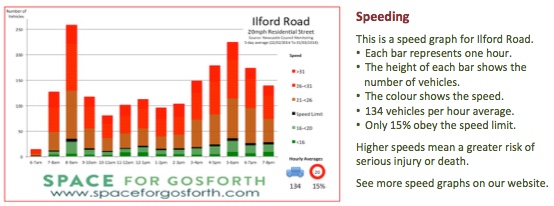
It is also clear that most of these residential streets are being used as cut-throughs for traffic in addition to their main purpose of providing access to people’s homes. The presence of so much traffic makes it harder to make these streets safe. Some streets in and around Gosforth have barriers to prevent through traffic making them much quieter and safer places to live. For example see Yetlington Drive, Rokeby Drive or Rothwell Road (links go to Google StreetView).
| Air Pollution The Gosforth Air Quality Management Area covers Gosforth High Street and Haddricks Mill Road. It has been in place since 2008 due to illegal levels of nitrogen dioxide (NO2). In 2017, Gosforth High Street had the highest recorded level of air pollution anywhere in the city. |
Even though long term air pollution is improving, Government advice still states that “Air pollution poses the biggest environmental threat to public health.”
In the Government’s Air Quality Plan for Nitrogen Dioxide it clarifies the main source of this pollution: “road vehicles contribute about 80% of NO2 pollution at the roadside and growth in the number of diesel cars has exacerbated this problem.” In 2017 there were 12.4 million diesel vehicles on the road, compared to less than 6 million in 2005, when NO2 emission targets first came into effect.

The Royal College of Physicians released a report in 2016 that estimated 40,000 deaths a year are linked to air pollution “The report notes examples [of the dangerous impact of air pollution] from right across an individual’s lifespan, from a baby’s first weeks in the womb through to the years of older age, including the adverse effects of air pollution on the development of the fetus, with emphasis on lung and kidney development, miscarriage, and increases in heart attacks and strokes for those in later life. Associated links to asthma, diabetes, dementia, obesity and cancer for the wider population are also included.”
In The Chronicle Councillor Forbes, leader of Newcastle City Council, has said: “I am really concerned that poor air quality is killing people in our city. We have figures that show that 360 lives are cut short every year due to poor air quality. This is not a sustainable position.”
Part of why we have highlighted the school run is because the Department for Transport has estimated that one in four cars at peak times are on the school run. It is not enough though just to tell parents to let their children walk and/or cycle. The roads need to be safe for them to do so.
All those children who are taken to school by car will be exposed to more air pollution than children who walk or cycle, even if they walk or cycle on the same polluted streets.
King’s College London have produce a video showing an experiment they tried measuring how the way we travel affects the amount of pollution we are exposed to.
The most recent official update for the year 2017 has just been released and it shows the north end of Gosforth High Street as having the worst reading for air pollution of any in the city.
The Council is now required to produce a plan to bring air pollution in Gosforth and Newcastle within legal limits within the shortest possible timescales. We should see this plan early in 2019.
If you want to find out more, SPACE for Gosforth has written widely on the subject of air pollution including:
– Air Quality Update 2017
– Air Quality Update 2016
– The dangers of air pollution – Dr Chris Stenton
– February 2018 Policy Cabinet Meeting – Air Quality
– 2018 – 10 years of the Gosforth and City Centre AQMAs
– Alive After 65 – Live Long with Clean Air
– The New Newcastle Air Pollution Plan
– No idling – make every day a cleaner air day
FINALLY…
Sunday 18 November is World Day of Remembrance for Road Traffic Victims. Please spare a thought for those that have lost friends and loved ones as a result of a road traffic collision.
Notes on Funding / Acknowledgements
The printing and distribution of the survey leaflet has been made possible by Ward Funding from the former East and West Gosforth wards and from Parklands ward. Ward Funding is available for small scale projects that benefit the local community, which can include the sharing of information to raise awareness of issues. Details of criteria that applications must meet and how to apply are available here. Details of awards made are recorded in ward meeting minutes available from the Council website and/or available from the Council Communities team.
In December 2017, SPACE for Gosforth applied for funding from former East and West Gosforth wards totalling £959.20 and was awarded £707.03, made up of £297.13 from East Gosforth and £409.90 from West Gosforth. More recently Parklands ward Councillors agreed to top this up by a further £307 to allow us to print and distribute leaflets to households in Parklands ward. For context the total Parklands ward budget for this financial year is £5,807. SPACE for Gosforth is also contributing additional funds to deliver leaflets to approximately 1200 addresses in Coxlodge east of Kenton Road.
As well as printing and distribution to households in the three wards, the funding will also allow us to hold a public meeting to present the results to any residents that are interested. We will share details of the meeting via our email list and on Facebook and Twitter once dates are confirmed.
The preparation of the survey/leaflet has been the result of many hours of unpaid work by SPACE for Gosforth members over a long period, and we are very grateful for everyone who has given their time to help get to where we are, and to everyone who has offered to assist in future with the analysis and presentation of the survey results. We are also very grateful to local company Autism Works for agreeing to manage the receipt of paper surveys submitted via the post and to local residents’ groups for support in sharing the survey and encouraging people to respond.
In submitting this application our main objectives were to:
(a) share information we have gathered via a fact-sheet to provide residents with a useful resource to help understand local transport-related issues; and
(b) seek input and views from local residents relating to issues, priorities and ideas for addressing those issues.
We would welcome your feedback on whether we have met these aims and/or any offers of help or suggestions for future activities.
The original application also included a request to fund a SPACE for Gosforth banner and business cards to assist engagement at community events, however we currently do not expect that we will have sufficient funds to cover these from the Ward Funding.
A copy of the application form as submitted to East and West Gosforth wards is available here for anyone who is interested.

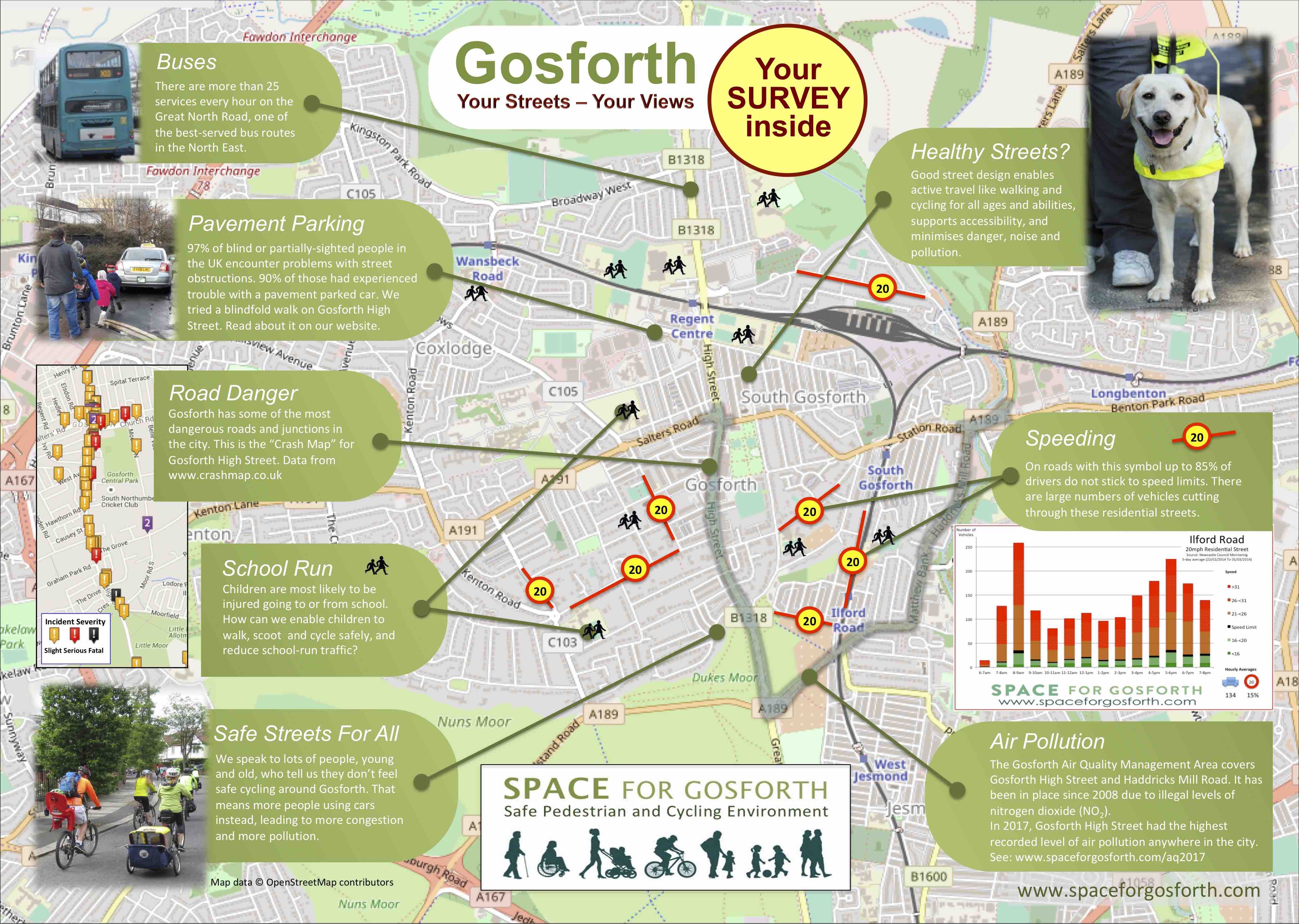
The roads, junctions and roundabouts are not dangerous. Some driving is.
The speed limit of 50 mph on some sections of the Great North Rd is excessive. There are no safe pedestrian / bike crossing points between Moor Crescent and Forsyth Rd. Just reduce the limit to 20 mph throughout the city, levy a charge all car parking spaces and give the money to the Council, ban all non-resident parking within 1/2 mile of schools.